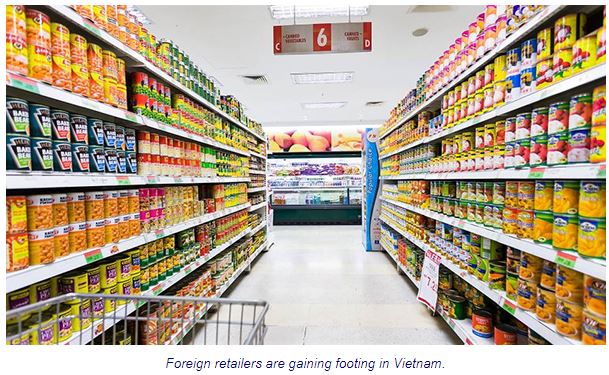Vietnam’s retail space market: Foreigners vie for bigger slice of cake
The Hanoitimes – In the race to gain market share in retail space, many people are worried about the inferiority of domestic investors before the progress of big players from Japan and Thailand.
The market penetration race
Total retail sales of goods and consumer services in 2018 increased by 12.2% compared to 2017. In fact, the Vietnamese retail market is on the rise with great attraction for foreign businesses. A series of famous retailers from Japan, Thailand, South Korea and France have rushed into Vietnam to compete for market share.
In particular, it is worthy mentioning important milestones in the Vietnamese market for foreign retailers. At the end of 2014, Berli Jucker Plc (BJC) acquired Metro Cash & Carry Vietnam for EUR655 million, becoming the largest M&A deal up to then, marking the presence of Thai businesses in the Vietnamese retail market. Not long after that, Central Group, another big player from Thailand, also acquired household appliance retailer Nguyen Kim and then BigC.
In October 2015, Emart – Korea’s leading retailer – stepped into Ho Chi Minh City when launching a shopping center worth US$60 million. In addition, Lotte Mart has been quite successful here with 11 supermarkets and is expected to increase its market share with 60 outlets by 2020.
Most Japanese investors see Aeon’s success in Vietnam as an encouraging sign. Aeon has opened four shopping malls in Vietnam and they have great ambition to increase this number to 20 by 2020. Meanwhile, Saigon Centre Shopping Mall in Ho Chi Minh City welcomed the presence of a key tenant – Takashimaya in July 2016.
Launching three more Simply Mart stores in Ho Chi Minh City, AuchanSuper – a retail brand from France – also plans to open another 17 supermarkets by the end of next year in Saigon and 20 stores by 2020 in some provinces in northern Vietnam.
Major fashion brands such as Gap, Mango, and Topshop have become the top choice of many Vietnamese youngsters. In early September 2016, Zara opened its first flagship store in Ho Chi Minh City and then Hanoi. Not only Zara, H&M also completed procedures to join the Vietnamese market in 2017.
Core factor of retail development
Vo Thi Khanh Trang, head of research at Savills Ho Chi Minh City, said that the core factor of the development of Vietnam’s retail industry is the rapid changing behavior of consumers. And developers have to bear this in mind when devising their projects as well as the structure of suitable tenants.
Sharing the same view, a report by JLL indicates an increase in disposable income, the urbanization rate and the rise of the middle class have made Vietnam one of the most dynamic emerging economies in Southeast Asia.
Besides, the increasing number of international tourists and the continued improvement of infrastructure make Vietnam an attractive destination for many retailers. In this context, rising supply and demand for retail space in Ho Chi Minh City and Hanoi in the third quarter of 2018 signaled a positive prospect for the retail space market.
However, in the context of increasing competition, many projects have to close or reduce the retail area, especially the department store segment. Many commercial centers have to renovate their architecture. They constantly refresh and offer many discounted programs or events to attract shoppers, thereby pretend to improve the business situation. The development of e-commerce is also a challenge for investors to develop retail space.
In the race to gain market share in retail space, many people are worried about the inferiority of domestic investors before the progress of big players from Japan and Thailand.
The whirlwind penetration of foreign retailers into Vietnam recently has made the retail market more competitive. The retail market will be a battle and only retailers who have the right strategy to meet the market demand will be able to gain market share, said Stephen Wyatt, general director of JLL Vietnam.
Stephen Wyatt said such worry is understandable because modern consumers have smart shopping habits. Quality and diversity will be the top choice, and these two criteria are the absolute advantage of foreign retailers, while being the shortcoming of many local retailers.
According to the development plan of supermarkets and commercial centers of the Ministry of Industry and Trade until 2020, with a vision to 2030, the proportion of retail goods through supermarkets and shopping malls by 2018 only accounted for 30% and will reach 45% by 2020. Currently, traditional retail channels still account for a large proportion nationwide, especially in areas beyond Hanoi and Ho Chi Minh City.
Source: http://www.hanoitimes.vn/economy/2019/02/81E0D305/vietnam-s-retail-space-market-foreigners-vie-for-bigger-slice-of-cake/


 Thailand
Thailand




